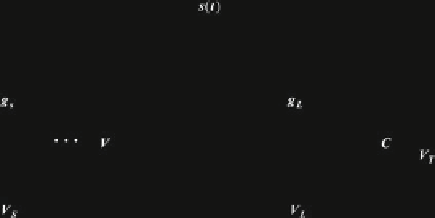Information Technology Reference
In-Depth Information
Fig. 7.3
The
integrate-and-fire biological
neuron model is represented
as a resistance-capacitance
circuit
which in discrete form is written as
V
nCh
D V
n
C h.I
n
aV
n
/ C
p
h N.0;1/
(7.33)
By integrating Langevin's equation in time one obtains
x.t/ D x.t
0
/ C
R
t
t
0
a.x.s/;s/ds C
R
t
t
0
b.x.s/;s/
dW
.s/
(7.34)
In the integrate-and-fire model the neuron dynamics is described as an electric
circuit, as shown in Fig.
7.3
[
45
,
75
]. This is in accordance with the simplified
Hodgkin-Huxley model in which spatial variation of the voltage is not taken into
account. The state variable is taken to be the membrane's potential V
C V D
P
i
I
i
.t/
(7.35)
where C is the neuron membrane capacitance, V is the neuron membrane voltage,
and I
i
is a current (flow of charge) associated with the membrane. The equivalent
circuit representation of the integrate-and-fire neuron is a resistance-capacitance
(RC) circuit.
In Fig.
7.4
it is shown how the parts of the biological neuron are modeled by
the local RC circuits and how spikes are generated. The neuron's membrane is
activated by input current s.t/. The membrane's capacitance C
m
is in parallel to
the membrane's resistance R
m
(or equivalently to the membrane's conductance g
m
)
and is driven by the synaptic current s.t/. The synaptic current s.t/is affected by the
synapse's resistance R
syn
and the synapse's capacitance C
syn
. When the membrane's
(capacitor C
m
) voltage V exceeds threshold V
T
a spike occurs and the voltage is
reset to V
R
. The integrate-and-fire model of the neuron dynamics can be extended
to the case of multiple interconnected neurons, as shown in Fig.
7.5
.
Currents s.t/ are considered to be due to the inflow and outflow of ions such as
K
C
,Cl
,Na
C
,orCa
C
. The membrane potential was shown to be associated with
the concentration of electric charges. Currents s.t/ which appear in the previous




































